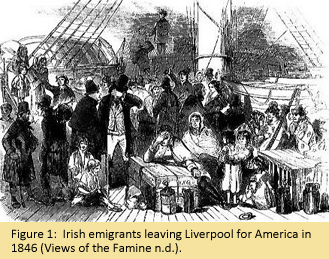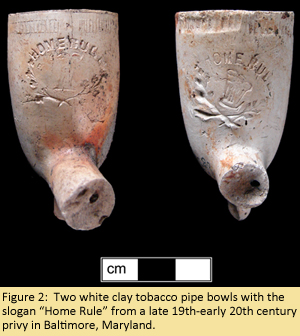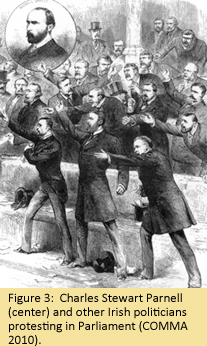Erin Go Bragh! "Home Rule" Tobacco Pipes
and Ireland's Struggle for Independence
March 2013
By Rebecca Morehouse, MAC Lab State Curator
 During the mid-19th century, Irish immigrants flocked to America to escape the Great Irish Potato Famine (Figure 1). The famine, which lasted from 1845 to 1852, was brought on by potato blight, a disease that devastated the potato harvests across Europe. In Ireland, where approximately one third of the population was entirely dependent on the potato for food, the famine reduced the population by almost two million, many of whom immigrated to the United States (Irish Potato Famine 2012).
During the mid-19th century, Irish immigrants flocked to America to escape the Great Irish Potato Famine (Figure 1). The famine, which lasted from 1845 to 1852, was brought on by potato blight, a disease that devastated the potato harvests across Europe. In Ireland, where approximately one third of the population was entirely dependent on the potato for food, the famine reduced the population by almost two million, many of whom immigrated to the United States (Irish Potato Famine 2012).
During this mass exodus, Maryland experienced a marked increase in its Irish population as some of those fleeing Ireland landed in Baltimore. Many of the Irish settled in the southwestern portion of the city known as Pigtown, so named for the practice of herding pigs through the streets from the rail yard to the slaughterhouses in south Baltimore. Many of the Irish men found work with the Baltimore and Ohio Railroad, while the women worked primarily as domestics (Teaching American History in Maryland n.d.). By the late 19th and early 20th centuries, many Irish immigrants still lived in Pigtown but had moved into more semi-skilled and clerical jobs (Goodwin et al. 1992: 207). In the early 1990s, archaeological evidence of the residences of some of these immigrants was uncovered during excavations conducted prior to the construction of stadiums for the Baltimore Orioles and Baltimore Ravens.
 This large scale project, which was conducted by R. Christopher Goodwin and Associates, Inc., identified the remains of several 19th and early 20th century row houses and industrial buildings, as well as the remains of a stoneware kiln. Several of the residences had associated privies, which yielded thousands of artifacts, providing a window into the lives of Pigtown’s working class residents. One privy, at site 18BC80, is of particular interest because it yielded two white clay tobacco pipes with the words “Home Rule” stamped above a Celtic harp with sprigs of clover (Figure 2). These pipes, with their Irish symbolism, were likely owned by first or second generation Irish immigrants living in one of the associated dwellings (Goodwin et al. 1992: 227).
This large scale project, which was conducted by R. Christopher Goodwin and Associates, Inc., identified the remains of several 19th and early 20th century row houses and industrial buildings, as well as the remains of a stoneware kiln. Several of the residences had associated privies, which yielded thousands of artifacts, providing a window into the lives of Pigtown’s working class residents. One privy, at site 18BC80, is of particular interest because it yielded two white clay tobacco pipes with the words “Home Rule” stamped above a Celtic harp with sprigs of clover (Figure 2). These pipes, with their Irish symbolism, were likely owned by first or second generation Irish immigrants living in one of the associated dwellings (Goodwin et al. 1992: 227).
The slogan “Home Rule” was popularized in Ireland by Isaac Butt, a Protestant lawyer who formed the Home Government Association in 1870, which supported Irish independence from British rule. In 1873, the Association was replaced by the Home Rule League and the moderate Isaac Butt was replaced by the more aggressive Charles Stewart Parnell (Figure 3), who used obstructionist tactics in the British parliament to publicize Irish grievances (Encyclopedia Britannica 2013). By 1885,  the British Prime Minister, William Gladstone, announced his support for Home Rule and introduced bills into Parliament in 1886 and 1893, both of which were defeated in the House of Lords. In 1914, a Home Rule Bill finally became law, but did not actually take effect until after the end of World War I, with the counties in Northern Ireland adopting a system akin to Home Rule in 1920 and remaining southern counties in 1921 (Encyclopedia Britannica 2013).
the British Prime Minister, William Gladstone, announced his support for Home Rule and introduced bills into Parliament in 1886 and 1893, both of which were defeated in the House of Lords. In 1914, a Home Rule Bill finally became law, but did not actually take effect until after the end of World War I, with the counties in Northern Ireland adopting a system akin to Home Rule in 1920 and remaining southern counties in 1921 (Encyclopedia Britannica 2013).
The Home Rule movement found its way to the United States when Charles Stewart Parnell visited America in 1879, planting the seeds of discontent among Irish immigrant communities (Alexander 1986: 69). Tobacco pipes with the Home Rule slogan and those with more subtle Irish-themed slogans, such as Erin Go Bragh (Ireland Forever), or Celtic symbols, such as the harp or shamrock, have been found on several sites associated with Irish immigrants in the United States (Alexander 1986: 69-75). These pipes would have allowed the immigrants living in Baltimore to show solidarity with their brothers and sisters fighting for independence back home in Ireland, as well as allowed them to display their nationalist pride.
Tobacco pipes with marks similar to the ones recovered from the privy in Baltimore have been found at the following sites in Maryland: 18AP63, the Anne Arundel Courthouse site (Banneker Douglass Museum Blog 2008); 18BA314, Irish Workers Barracks site (Payne and Baumgardt 1994: II-41); and 18PR963, the Market Master’s House (Bladensburg Archaeology Project Blog 2009). One was also found at the Willa Herman Bordello site in Idaho (Swords 2012).
| References |
|
| Alexander, L.T. |
| 1986 |
"Clay Pipes with Irish Affiliations" in Historic Clay Tobacco Pipe Studies, Volume 3. Edited by Byron Sudbury. Privately published. |
|
| Banneker Douglass Museum Blog |
| 2008 |
Anne Arundel County Courthouse, Part II, entry for November 12, 2008. Accessed February 22, 2013. http://bannekerdouglassmuseum.blogspot.com/ 2008/11/anne-arundel-county-courthouse-part-ii.html. |
|
| Bladensburg Archaeology Project Blog |
| 2009 |
Artifacts in Focus: "Home Rule" Pipe Bowl Fragment, entry for September 1, 2009. Accessed February 22, 2013. http://bladenarch.blogspot.com/ 2009/09/artifacts-in-focus-home-rule-pipe-bowl.html. |
|
| COMMA |
| 2010 |
Irish Politicians in British Parliament. Accessed February 22, 2013. http://comma.english.ucsb.edu/content/irish-politicians-british-parliament. |
|
| Encyclopedia Britannica |
| 2013 |
Home Rule. Accessed February 22, 2013. http://www.britannica.com/EBchecked/topic/270116/Home-Rule |
|
| Goodwin, R. Christopher et al. |
| 1992 |
Archeological and Architectural Investigations at Camden Yards, Baltimore, Maryland. Report prepared for the Maryland Stadium Authority. On file at the Maryland Historical Trust, Crownsville. |
|
| Irish Potato Famine |
| 2012 |
The Great Irish Potato Famine: Images and Stories of the Irish Potato Famine. Accessed February 22, 2013. http://irishpotatofamine.net/ |
|
| Payne, Ted and Kenneth Baumgardt |
| 1994 |
Beaver Dam Road Widening: Phase III Archeological Investigations at Nineteenth Century Irish Worker Residential Sites: 18BA313, 18BA214, and 18BA325. Report prepared for Whitney, Bailey, Cox and Magnani. On file at the Maryland Historical Trust, Crownsville. |
|
| Swords, Molly |
| 2012 |
Sometimes I Finish Six Seemingly Impossible Tasks Before Lunch. Day of Archaeology Blog, entry July 1, 2012. Accessed February 22, 2013. http://www.dayofarchaeology.com/sometimes-i-finish-6-seemingly-impossible-tasks-before-lunch/ |
|
| Teaching American History in Maryland: Documents for the Classroom, Maryland State Archives |
| n.d. |
Irish Immigrant in Baltimore. Accessed February 22, 2013. http://teachingamericanhistorymd.net/000001/000000/000131/html/t131.html |
|
| Views of the Famine |
| n.d. |
The Pictorial Times. Accessed February 22, 2013. http://adminstaff.vassar.edu/sttaylor/FAMINE/ |
|